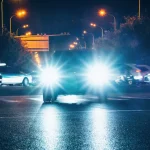Safety First: Exploring the Latest Car Safety Technologies and Ratings

Comparative to when airbags were first introduced 30 years ago, today’s standard safety features include much more. These features now rely heavily on technology such as cameras, radar and sensors to help drivers avoid accidents and injuries.
Many of these systems also function while the car is stopped and can provide warning or assistance with navigating narrow lanes. They may feature visual alerts, vibration feedback or sound alerts.
Lane Departure Warning
This technology forms part of a second wave of driver assistance technologies using cameras, sensors, lasers and more that help maintain control over your car in dangerous situations. It works by monitoring where your vehicle sits in traffic lanes and alerting you when it nears crossing solid or dotted lane lines – even without activating its turn signal!
Some systems use cameras to scan for lane markings while others rely on radar, laser or visual sensors. When someone crosses into their lane unintentionally, some sound warning beeps while some vibrate steering wheels or seat cushions for added haptic feedback warnings. Some also utilize gentle braking mechanisms in order to keep their car within its lane – although this feature only works at relatively high speeds.
Blind Spot Monitoring
Blind spot monitoring (BSM) systems can help lower your risk of collisions. BSM uses radar sensors or rear-mounted ADAS camera sensors to keep tabs on areas around your vehicle that aren’t covered by side and rearview mirrors – when someone enters one of your blind spots an alert is triggered and you are warned.
BSM systems may alert drivers using visible lights, audible sound alerts or tactile vibrations. BSM is proven to significantly decrease rates of single vehicle sideswipes and head-on crashes; with all drivers equipped with BSM systems like those tested by IIHS annually over half a million lane change/merge accidents could be avoided and injuries significantly reduced – visit MINI of Burlington now to gain further insights into these amazing safety features!
Rear Cross-Traffic Alert
Rear cross traffic alert uses similar sensor technology as blind spot monitoring to keep an eye out for vehicles or pedestrians approaching from either side of your car when backing out of a parking spot, thus helping prevent back-end parking lot collisions by alerting drivers with both audible and visual warnings.
On activation while driving in reverse gear, the system uses sensor data to generate audible and/or haptic feedback warnings using sensor information gathered by its sensors; such warnings may include visual alert symbols for crossing traffic alerts within real-time rear vision display images. This feature often comes bundled together with blind spot monitoring technology offered as part of Toyota Safety Sense.
Rear cross-traffic alert can help keep an eye out for vehicles moving around you in parking lots, which are sometimes hard to see due to walls or other vehicles obstructing their view. Twenty percent of car accidents take place in parking lots each year; rear cross-traffic alert helps prevent insurance claims by monitoring for back-up fender benders that could occur behind you.
Lane Keeping Assist
Lane departure is one of the primary causes of road accidents and it often arises as a result of driver fatigue. To combat this issue, cars now come equipped with systems to detect when an unwittingly drifts off course.
Most lane departure warning (LDW) systems feature audible or visual alerts as soon as a car approaches or crosses over lane markings, as well as tactile feedback via steering wheel pulsations or seat cushion pulsations.
Lane keeping assist (LKA) technology goes one step further by manipulating steering to keep your vehicle within its lane. These level 2 automated driving technologies should not fool you – you still must keep both hands on the wheel and be attentive while driving.
Forward Collision Warning
Many new cars now include forward collision warning systems that detect objects in their path, including other vehicles and pedestrians. These systems use radar sensors, cameras, or lasers to alert drivers through visual, audible, or tactile methods depending on their design and the owner manual of their respective vehicle.
FCW systems act like ever-vigilant watchmen, alerting drivers of potential danger and warning them in time. Their abilities vary between city speeds and freeway speeds; some can even include automatic emergency braking (AEB) to mitigate or avoid collisions altogether. But FCW systems should never replace being attentive while driving!






